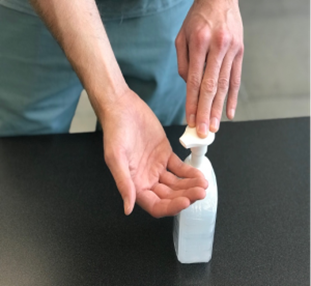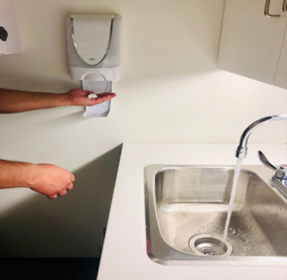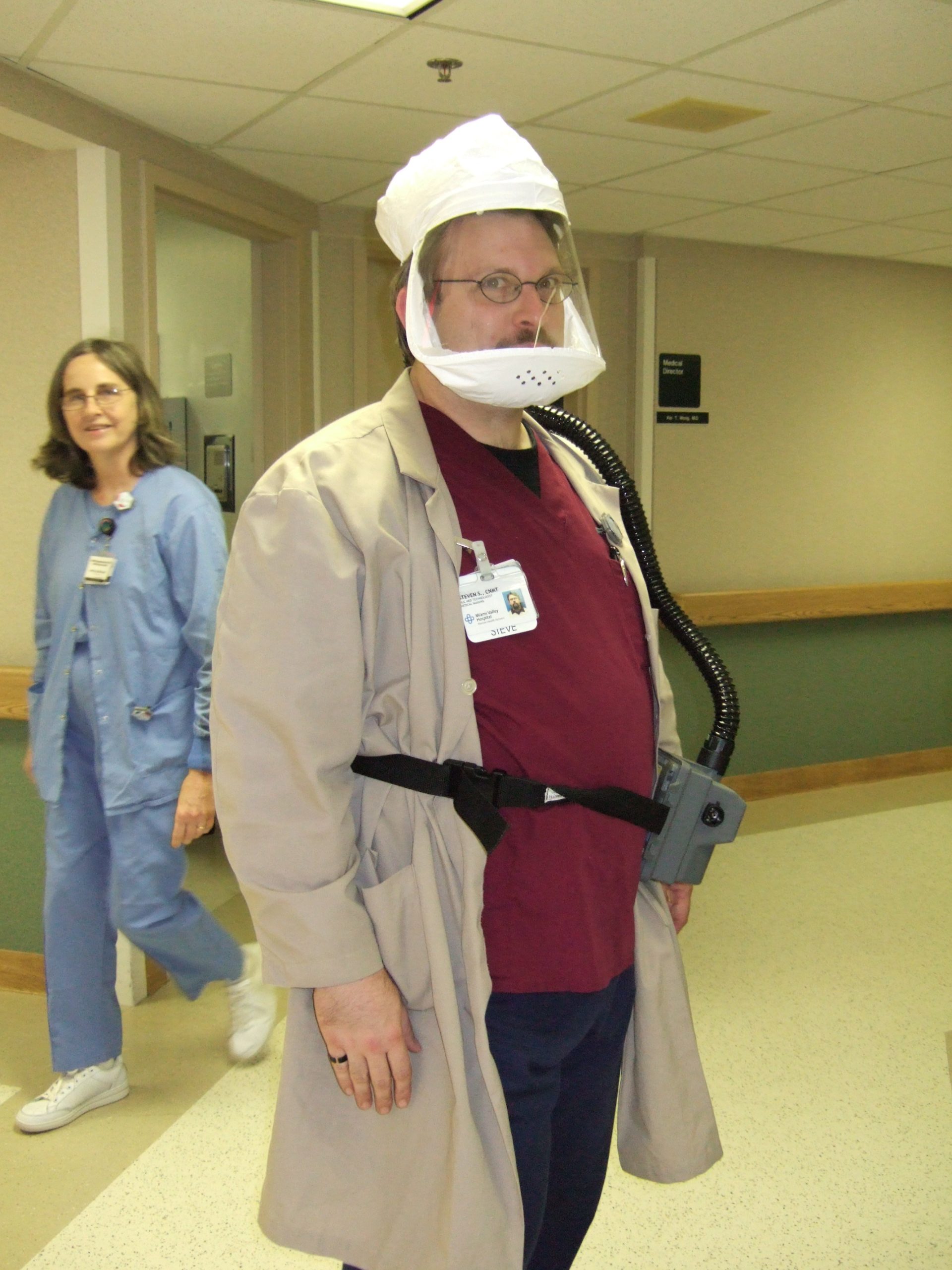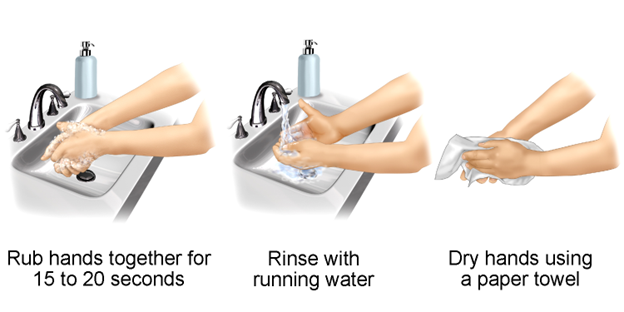2.1 Infection Control
Hand Hygiene and Personal Protective Equipment
Respiratory therapists are on the front lines treating all types of respiratory diseases. It is important that they are knowledgeable in infection control and prevention of disease. As respiratory therapy students, you are responsible for learning about infection prevention and control practices, becoming competent in infection prevention and control skill techniques, and becoming knowledgeable in infection prevention and control guidelines according to your role. To gain competency in infection prevention and control skills, students need to continuously practice in the classroom and laboratory settings and then apply what they have learned throughout their health care placement with supervision and support from their clinical instructor or placement preceptor and faculty. As health care students, you must work in collaboration with other health care providers and students to create a safe environment.
Health care providers’ hands are the most common mode of transmission of microorganisms. As health care providers, your hands will touch various people and objects when providing care. As such, microorganisms can easily transfer from your hands to objects in the health care setting when proper hand hygiene practices are not followed. When you touch a client, their personal items, medical equipment, or the surrounding environment, you can indirectly transmit microorganisms to the client, another client, yourself, equipment, or transfer it to a new environment. Consistent and effective hand hygiene is required to break the chain of transmission.[1]
Hand Hygiene[2]
There are two methods of hand hygiene commonly used in the health care setting: hand hygiene with an alcohol-based hand rub (see Figure 3[3]) and hand hygiene with soap and water (see Figure 4[4]).
| Alcohol-Based Hand Rub (ABHR) | Soap and Water |
|---|---|
| Preferred method when hands are not visibly soiled (e.g., blood, body fluids, waste). | Preferred method when hands are visibly soiled to remove organic matter. |
| Takes less time. | Performed with suspected or confirmed diagnosis of C. difficile, norovirus, and Bacillus anthraces. |
| More effective. | Takes more time. |
| Less drying and irritating to hands. | Washing, rubbing, rinsing, and drying actions remove most transient bacteria. |
| Rubbing action until the ABHR is dry on hands, which should take approximately 20 seconds, is important to remove and kill transient bacteria. | Harsher on hands and increases risk of skin breakdown. |
 |
 |
Alcohol-based hand rub (ABHR) products, soap dispensers, and hand-washing sinks should be accessible at the point of care and placed in convenient locations for health care providers and visitors to use before and after client contact. The respiratory therapist should note that washing hands with soap and water is very effective at destroying germs because the lathering of hands with the soap molecules, and scrubbing creates friction that helps destroy some bacteria and viruses and lifts and washes away dirt, grease and other microbes under running water.[5]
View the following supplementary YouTube videos[6],[7] to learn more about using the soap and water technique or the alcohol-based hand rub (ABHR) for proper hand hygiene for health care workers:
Personal Protective Equipment
As a respiratory therapy student, infection prevention and control techniques may not always seem intuitive. There are general rules and guidelines that can help you as you begin to practice safe care according to infection prevention and control guidelines. When using personal protective equipment (PPE), the first step is knowing the sequence to put on and remove PPE safely.
View the following supplementary YouTube video[8] to learn more about the proper way to don and doff PPE:
Gloves
- Gloves are critical for preventing the transmission of microorganisms, and it is important to wear them with all patient interactions, not just when you are handling bodily fluids. Ensure that gloves are removed and disposed of correctly.
Masks
- Medical masks protect the mucous membranes of the nose and mouth and should be worn during care, treatments, or procedures that may cause splashing or spraying of blood, body fluids, secretions, or excretions (i.e., intubation and extubation); when within 3 feet of a client who is coughing; or when required by routine practices or additional precautions (see Figure 5[9]).

N95 Respirators
- Respirators protect the mucous membranes of the nose and mouth and have a high-filtration material that is more effective than medical masks in protecting the wearer from smaller airborne particles.
- Respirator masks are designed to fit snugly. Because faces vary in size and shape, respirators need to be specifically fitted. Every time a respirator is put on, a seal test must be done.
- Depending on the health care organization, a powered air purifying respirator (PAPR) may be used in place of a N95 mask to protect the health care worker (see Figure 6[10]).

Gowns
- Gowns protect from splashing or spraying of body fluids, as well as from the transmission of microorganisms.
- Gowns should have long sleeves with a snug fit at the wrist, cover both the front and the back of the body from the neck to the thighs, and overlap at the back.
- Ensure that the gown is worn correctly and that the ties on the gown are secure. Gowns need to be removed in a way that prevents contaminating clothes and skin.
Eye Protection
- Eye protection, including face shields, visors attached to masks, and goggles, are used to protect the eyes of health care providers when procedures or care activities are likely to cause splashing, spraying of body fluids, or when within 3 feet of a coughing client. When intubating, extubating, and suctioning with an exposed catheter, eye protection should be utilized by the therapist.
Cleaning, Disinfection, and Sterilization
Health care settings have multiple people and pieces of equipment continuously coming in and out of the environment. Each of these individuals and items can potentially introduce new microorganisms into the environment. They may bring in infectious microorganisms, visit infectious clients, or touch contaminated surfaces. The continuous movement of people within the health care setting and their continuous interactions with the environment increase the risk of transmission of infectious agents.
One way to decrease the transmission of infectious agents is effective cleaning and disinfecting of the health care environments (e.g., table surfaces, clients’ personal items, medical equipment; see Figure 7[11]). Routine cleaning and disinfecting practices can help to reduce the transmission of microorganisms and decrease the risk of health care-associated infections (HAIs). It is essential for health care providers to understand the various risks of transmission, the required cleaning, disinfection, or sterilization needed according to the setting and the cleaning products to use according to agency policies.

Before cleaning any surface, you need to determine what type of cleaning agent and disinfectant is compatible with the equipment. Familiarize yourself with your institutional policies and check manufacturer instructions (e.g., dilution rates, contact time, frequency, compatibility, safety considerations) if unsure. Identify and label any damaged equipment, and report it to the proper department (e.g., environmental services manager, occupational health department). All equipment should come with the manufacturer’s instructions for assembling/disassembling and cleaning (e.g., mechanical lifts, hospital beds, wheelchairs, ventilators). Cleaning agents and disinfectants required for medical equipment or surfaces should be readily available and approved for use at the health care setting according to the infection prevention and control guidelines.
Cleaning refers to the physical removal and reduction of foreign (e.g., dust, soil, grease, oils) and organic (e.g., blood, body secretion, microorganisms) materials from a surface through the use of mechanical action, water, and detergents. Cleaning is the first step in reprocessing, and if not performed correctly, all other steps are invalidated. Cleaning can be a one-step (e.g., soap and water) or two-step (e.g., bleach [sodium hypochlorite] and hydrogen peroxide cleaner disinfectant wipes) process depending on the surface, type of microorganism, and amount of contamination. The physical movement of friction is key when cleaning a surface area.
Disinfecting refers to the process of deactivating and killing most microorganisms (usually not effective against spores) through the use of disinfectants. High-level disinfection is used for semi-critical respiratory items. Examples include bronchoscopes, laryngoscope blades, temperature probes, and resuscitation bags. There is no one disinfectant solution that will work for every microorganism and in every setting. Examples of disinfectants include alcohol, hydrogen peroxide, bleach, iodophors, phenolics, and quaternary ammonium.
Sterilization refers to the process of killing all microorganisms through a physical (steam autoclave) or chemical (ethylene oxide) means. Medical devices contacting sterile body tissues or fluids are critical items and should be sterile before use.
Mode of Transmission
The mode of transmission is how the infectious agent travels and spreads from one person to another, either directly or indirectly.
These include:
- Contact transmission—Occurs directly by touching an infectious client with your hands, or indirectly by touching fomites, which are items or medical equipment that are contaminated with the infectious agent.
- Droplet transmission—Occurs through respiratory secretions from talking, sneezing, coughing, or laughing; droplets can travel up to 2 meters.
- Airborne transmission—Occurs through small nuclei traveling on air currents for long distances (over 2 meters).
- Vehicle transmission—Occurs through vehicles such as water, food, or air.
- Vector transmission—Occurs through living organisms that can transmit the infectious agent between humans biologically (e.g., mosquitoes) or mechanically from an animal to a human (e.g., fly or tick).[12]
View the following supplementary YouTube video[13] that describes modes of disease transmission in more detail: Modes of Transmission Explained | Lecurio Nursing Public Health
Chain of Transmission
An infectious agent is also known as a pathogen and causes the disease in the host. The reservoir can be a living organism or inanimate object where the infectious agent lives, survives, and has the ability to multiply and grow. The portal of exit is how the infectious agent leaves the reservoir or host. The mode of transmission is how the infectious agent travels and spreads from one person to another, either directly or indirectly. The portal of entry is how the infectious agent enters another person’s body or new host. A susceptible host is anyone who is at risk of the infectious agent. However, some individuals are more susceptible than others.
In the activity below, drag the description over the correct term.
Isolation Precautions
When a patient is suspected or confirmed to have an infectious pathogen, health care workers must implement additional precautions beyond routine practices to prevent the spread of infection. These precautions are determined by the mode of transmission, which can be categorized as standard, contact, droplet, or airborne.
Standard Precautions
Standard precautions are a set of infection control practices used to prevent transmission of diseases that can be acquired by contact with blood, body fluids, nonintact skin (including rashes), and mucous membranes. These measures are to be used when providing care to all individuals, whether or not they appear infectious or symptomatic. These include hand hygiene, PPE, sharps and needlestick prevention, cleaning and disinfection, respiratory hygiene, and waste disposal.[14]
Types of Additional/Isolation Precautions
There are three categories of additional precautions: contact precautions, droplet precautions, and airborne precautions.
Contact precautions are the most common type of additional precautions. They are used in addition to routine practice for patients who are known or suspected to be infected with microorganisms that can be transferred by direct (touching) or indirect (shared equipment) contact. Types of organisms in this category are antibiotic-resistant organisms (AROs) such as methicillin-resistant Staphylococcus aureus (MRSA), vancomycin-resistant Enterococci (VRE), extended-spectrum beta-lactamase (ESBL), Clostridium difficile (CDI), carbapenemase-producing organisms (CPO), diarrhea, and scabies. Antibiotic-resistant organisms (AROs) are also known as multi-drug-resistant organisms (MDROs). If the patient is on contact precautions, you need to wear gloves and a gown if your skin or clothing will come into direct or indirect contact with the client or the contaminated environment.
Droplet precautions are used in addition to routine practices for patients who are known or suspected to be infected with microorganisms that are spread through the air by large droplets. Types of organisms and unconfirmed conditions in this category include mumps, influenza, vomiting of unknown cause, norovirus, and unconfirmed cough. If the patient is on droplet precautions, you need to wear a gown, gloves, mask, and eye protection.
Airborne precautions are used in addition to routine practices for patients who are known to have or are suspected of having an illness that is transmitted by small droplet nuclei that may stay suspended in the air and be inhaled by others. These particles can remain infectious for a long period of time when spread through the air. Types of organisms in this category include tuberculosis (TB), measles, chicken pox (varicella), disseminated zoster, and severe acute respiratory syndrome (SARS). If the patient is on airborne precautions, the patient must be placed in a negative-pressure room, and you must wear a fit-tested N95 respirator mask, gown, gloves, and eye protection.
The type of hand hygiene required depends on the diagnosis. For example, you can use an alcohol-based hand gel for clients diagnosed with influenza or MRSA. However, for clients diagnosed with C. difficile, you need to wash your hands with soap and water (see Figure 8[15]).[16]

- Hughes, M., Kenmir, A., St-Amant, O., Cosgrove, C., & Sharpe, G. (2021). Introduction to infection prevention and control practices for the interprofessional learner. OER Commons. https://ecampusontario.pressbooks.pub/introductiontoipcp/ ↵
- Hughes, M., Kenmir, A., St-Amant, O., Cosgrove, C., & Sharpe, G. (2021). Introduction to infection prevention and control practices for the interprofessional learner. OER Commons. https://ecampusontario.pressbooks.pub/introductiontoipcp/ ↵
- “Alcohol-based-Hand-Rub-.png” by unknown author are licensed under CC BY-NC 4.0. Access for free at https://ecampusontario.pressbooks.pub/introductiontoipcp/chapter/59/ ↵
- “Soap-and-Water-350x341.png” by unknown author are licensed under CC BY-NC 4.0. Access for free at https://ecampusontario.pressbooks.pub/introductiontoipcp/chapter/59/ ↵
- The Regents of the University of California. (2025). Soap vs. hand sanitizer. UCI Health. https://www.ucihealth.org/blog/2020/04/soap-vs-sanitizer ↵
- RegisteredNurseRN. (2018, December 1). Hand hygiene for health workers | Hand washing soap and water technique nursing skill [Video]. YouTube. Used with permission. All rights reserved. https://www.youtube.com/watch?v=G5-Rp-6FMCQ ↵
- World Health Organization. (2015, October 15). WHO: How to handrub? With alcohol-based formulation [Video]. YouTube. All rights reserved. https://www.youtube.com/watch?v=ZnSjFr6J9HI ↵
- RegisteredNurseRN. (2020, May 29). PPE training video: Donning and doffing PPE nursing skill [Video]. YouTube. Used with permission. All rights reserved. https://www.youtube.com/watch?v=iwvnA_b9Q8Y ↵
- “49721624231” by MC2 Sara Eshleman for U.S. Navy is licensed in the Public Domain ↵
- "Portable_powered_HEPA_respirator" by Steven is licensed under CC BY 2.0 ↵
- “pexels-matilda-wormwood-4099467” by Matlida Wormwood via Pexels.com is licensed under CC0 ↵
- Hughes, M., Kenmir, A., St-Amant, O., Cosgrove, C., & Sharpe, G. (2021). Introduction to infection prevention and control practices for the interprofessional learner. OER Commons. https://ecampusontario.pressbooks.pub/introductiontoipcp/ ↵
- Lecturio Nursing. (2023, January 14). Modes of transmission explained | Lecurio Nursing Public Health [Video]. YouTube. All rights reserved. https://www.youtube.com/watch?v=QALD1Xexn8M&t=29s ↵
- Ernstmeyer, K., & Christman, E. (Eds.). (2024). Nursing fundamentals 2E. Open RN | WisTech Open. https://wtcs.pressbooks.pub/nursingfundamentals/ ↵
- “Hand_Hygiene” by BruceBlaus is licensed under CC BY-SA 4.0 ↵
- Wisconsin Department of Human Services. (n.d.). Healthcare-associated infections: Precautions. https://www.dhs.wisconsin.gov/hai/precautions.htm#:~:text=Standard%20precautions%20are%20a%20set,rashes)%2C%20and%20mucous%20membranes ↵

